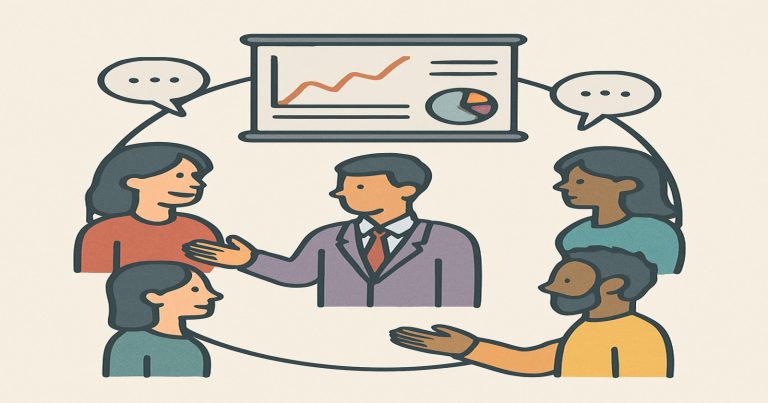Stakeholder engagement is the process of creating and maintaining a mutually beneficial relationship between the project and its stakeholders. That means listening to their perspectives, exchanging ideas and collaborating. A solid stakeholder engagement strategy fosters trust, collaboration and conflict reduction. What is stakeholder engagement, is a question get from students and professionals alike. The answer is simple. It ensures all stakeholders of any project feel listened to and valued.
When companies, schools, or governments launch any kind of new effort, they need to involve the people who will be included. These people may be employees, customers, partners, community members, or investors. Stakeholder engagement is talking to them and keeping them updated. This will assist in obtaining better thoughts and evading large issues down the road.
Online Stakeholder engagement is also seen today. It interacts with people via websites, emails, and social media. It speeds up and makes the process more transparent. Tools such as stakeholder engagement assessment matrix or a stakeholder engagement matrix assist managers in mapping and analysing the positions of each individual. Even, many companies prefer to hire stakeholder engagement service to do this job.
In this article, we will talk about the stakeholder engagement meaning, why it matters and how it is different from management. We will also understand make a plan, use digital tools and benefit better. These skills come in handy in the job and test scenarios for Indian students and professionals.
What is Stakeholder Engagement?
Stakeholder engagement: Stakeholder engagement refers to the actions taken to involve stakeholders throughout the decision-making process, project, or project plans. This includes feedback request, listening, revenue updates and doubt solution. It is a way to develop close relationships and facilitate fluid operation of your project.
Stakeholders or Stakeholder are individuals or organizations that have an effect on, or be affected by, the business or project. They include:
- Employees
- Customers
- Investors
- Suppliers
- Local community
- Government bodies
Stakeholder engagement is more than speaking with people. It involves creating trust, demonstrating respect and ensuring that all voices are represented. It is a two-way process. You tell them, and you also listen and adjust if necessary.
Engagement comes in two varieties:
- Internal stakeholder engagement – Staff, management or board members — people within the organization.
- External stakeholder engagement – Involves the public, vendors, clients, government officials and others outside the organization.
Whenever we start any new activity, one question we should always ask ourselves is – what is stakeholder engagement. It is the foundation of a successful and sustainable project.
A well-designed stakeholder engagement matrix provides a means to determine who to engage with more, and who to merely inform. Levels of interest/power will differ for each individual. Tools such as the stakeholder engagement assessment matrix make it easier to record engagement efforts and develop them over time.
Importance of Stakeholder Engagement
It aids in developing improved relationship and smooth workflow. It cuts down on time, cost, and errors. Lack of engagement of key people leads to failure of many projects in public and private domain- This holds true for many projects in India.
An effective stakeholder engagement plan establishes clear communication and trust. It really helps for us to avoid surprises and fights and everybody is on the same page working towards the same goals. Lets analyze why it is so Important:
Builds Trust and Transparency
The make them trust the project even more. They know the team is reputable and wants their feedback. This kinda trust helps in long term support.
Reduces Risks and Delays
One of the most common problems in a project is communication Issues. Managing stakeholders helps to detect problems early and resolve them. It minimizes protests, delays and expensive changes down the line.
Improves Project Design
Stakeholders discuss their ideas and needs. Does this help design better plans that work in reality? Their comments are all fresh ideas, and they save time.
Encourages Support and Ownership
The people support what they help to build. Such engaged stakeholders become internal champions for the project. They aid in making the purpose clearer and in gaining support for the work.
Legal and Ethical Meets & Legal and Ethical Standards
Several laws in India request public engagement. Large projects need to have public hearings and obtain approvals. A good plan meets these rules and keeps you out of trouble.
These reasons help to highlight the importance of stakeholder engagement. This is an intelligent approach to managing people, projects and risks as a single process.
Stakeholder Engagement Plan
With a stakeholder engagement plan, there is a roadmap for engaging with stakeholders. It covers identifying, connecting, informing, and engaging the right people.
Without a plan the process is jumbled. A plan allows everyone to understand their responsibilities and how to keep people in the loop. Let’s look at the key components of a solid plan.
How to Develop a Stakeholder Engagement Plan
- Identify Stakeholders-List everyone who has a say about or is affected by the project. Try finding out about them through surveys, team meetings or local records.
- Analyze Stakeholders- Be sure to review: Use tools such as the stakeholder engagement matrix or stakeholder engagement assessment matrix to see:
- Their interest in the project
- Their power to support or block it
- Their concerns and needs
- Set Engagement Goals- Decide what you want. It could be:
- Getting ideas
- Sharing updates
- Getting public support
- Solving problems early
- Choose Engagement Methods- At the same time decide how you want to address each stakeholder. This may be through emails, meetings, WhatsApp, or public events. Today, powerful digital stakeholder engagement tools such as video calls, webinars and polls also come into play.
- Create a Communication Plan- Specify what to say, how often, and in what language. Keep it clear and short.
- Monitor and Improve- Keep records. See what’s working and what’s not. Of course, you will not be able to satisfy everyone.
| Step | Action |
| Identify Stakeholders | Prepare a list |
| Analyze Stakeholders | Use tools of matrix |
| Set goals for engagement | Choose why you want to engage |
| Select methods | Choose mails, calls, online tools etc |
| Create a communication plan | Information-what, how & when |
| Monitor and improve | Collect feedback and revise plan |
There is some structure to a planned approach that random talks lack. The benefits of a stakeholder engagement plan: clarity, focus, and outcomes.
Stakeholder engagement versus stakeholder management
People often get confused between stakeholder engagement vs stakeholder management. But these two things are crucial and entirely distinct.
Stakeholder Management
This is all about planning and implementing how to work with stakeholders. It is not so much about not stopping them from stopping the project or creating a problem. It is one-sided.
Stakeholder Engagement
This is about two-way talk. It involves listening, sharing and collaborating. It also plays a role in value creation and sustainability.
Let’s compare:
| Feature | Stakeholder Management | Stakeholder Engagement |
| Style | Top down | Two way |
| Focus | Control | Relationship |
| Aim | Avoid problem | Trust & Support |
| Tools | Meetings & reports | Feedback tools |
The two are often confused by Indian students. But without engagement against mere engagement there is nothing, and there are lots of ways that you can actually do this, that isn’t just control.
Digital Stakeholder Engagement
As technology has evolved, digital stakeholder engagement is now commonplace in many projects. It’s basically telling and engaging people through online platforms.
It helps in big cities and rural India where people live away from the project site. You don’t have to travel long distance so it reduces travel cost. And, more people can get involved easily.
Common Digital Engagement Tools:
- Email campaigns
- WhatsApp groups
- Zoom/Google Meet calls
- Online forms and polls
- Project websites
- Social media platforms
Digital tools assist with issuing quick updates, gathering feedback, and documenting records. They are effective for online stakeholder engagement, particularly during lockdowns or for busy professionals.
But the online tools have their limits, too. In many places you have no internet. Others do not feel comfortable speaking online. Digital methods therefore should complement — not substitute for — face-to-face discussions.
Always look at your audience first before selecting tools. The best strategy is a shrewd combination of old and new methods.
Stakeholder Engagement Matrix & Assessment Matrix
The two primary tools that assist with planning are the stakeholder engagement matrix and the stakeholder engagement assessment matrix. It helps to know your stakeholders better.
Stakeholder Engagement Matrix
This indicates who gets to effect change in the organisation. You evaluate and then decide how much of your time and effort to devote.
Example layout:
| Stakeholder | Power | Interest | Actions |
| Government | High | High | Engaged closely |
| Media | High | Low | Satisfied |
| Shop owners | Low | High | Informed |
| Public | Low | Low | Only monitor |
Stakeholder Engagement Assessment Matrix
This, checks where each stakeholder is today and where you want them to be.
| Stakeholder | Current Status | Desire Status | Needed Strategy |
| Parents | Neutral | Supportive | Share benefits |
| Teachers | Supportive | Leading | Increase dialogues |
Implementing these tools saves time and leads to more successful projects. These matrices are used in many stakeholder engagement services in management consulting.
Relevance to ACCA Syllabus
The criticality of stakeholders to an organization and the need to engage with them forms a major part of the ACCA syllabus under the Strategic Business Leader (SBL) and Corporate and Business Law (LW) papers. ACCA students need to know how to build trust, manage stakeholders’ expectations, and apply ethical principles to governance and reporting matters.
Stakeholder Engagement ACCA Questions
Q1. Stakeholders are engaged primarily through what mechanism of corporate governance?
A. Minimizing business taxes
B. Enhance profitability of audits
C. Fostering trust and transparency
D. Reducing product prices
Ans: B Benefit is they are able to build trust and transparency by keeping stakeholders’s faith in the company.
Q2. A stakeholder is defined in the ACCA SBL syllabus as:
A. Only company shareholders
B. Firms engaged in auditing the accounts of other companies
C. Stakeholder — a person with an interest in, an impact on, or who influences the company
D. Only internal staff
Ans: C. Anyone who influences or affected by the business
Q3. What is the tool used to evaluate current vs. desired state of stakeholder engagement?
A. Budget variance report
B. SWOT analysis
C. Stakeholders Engagement Assessment Matrix
D. Balanced scorecard
Answer: C. Stakeholders engagement assessment matrix
Q4. You can tell they are both powerful and interested so how closely do you expect to need to work with them?
A. Local residents
B. Government regulators
C. Competitors
D. Delivery personnel
Ans: B. Government regulators
Q5. What is stakeholder engagement and why is it important?
A. To reduce salaries
B. To avoid any legal advice
C. To better align with stakeholders’ expectations
D. To limit product offerings
Ans: CTo better align with stakeholder expectations.
Relevance to US CMA Syllabus
The Strategic Financial Management and Performance Management components of the US CMA exam also focus on stakeholder expectations and engagement that support the alignment of goals to ethical, strategic, and performance-oriented outcomes.
Stakeholder Engagement US CMA Questions
Q1. There are several reasons why stakeholder engagement is an important concept to keep in mind in the context of performance management.
A. To support spending on marketing
B. To level off non-controlling interest
C. To ensure business objectives align with stakeholders needs
D. To eliminate cost centers
Answer: C. So that business goals align with stakeholder needs
Q2. What is used to best describe a stakeholder engagement matrix purpose?
A. Assessing Employee Performance
B. View machine efficiency
C. Stakeholders power and interest mapping
D. Calculating taxes
Ans: C – Mapping power and interest of stakeholders
Q3. What is the role that stakeholder feedback serves in budgeting?
A. Just to increase production
B. To delay project deadlines
C To allocate resources based on stakeholder preferences
D. To avoid risk assessments
Ans: C. To allocate resources as per stakeholder priorities
Q4. A CMA is preparing a sustainability report. Who to consult to preferably be sure that balanced interests are considered?
A. Tax accountants only
B. Customers and employees
C. Only internal auditors
D. Only the board of directors
ANSWER: B Customers and employees
Q5. What is the tool that measures stakeholder satisfaction in a project lifecycle?
A. Break-even chart
B. Net present value
C. Stakeholder engagement assessment matrix
D. Contribution margin ratio
Answer: C. Stakeholder engagement assessment matrix
Relevance to US CPA Syllabus
A CPA’s understanding of stakeholder engagement helps them to maintain transparency and adhere to legal standards in the BEC and REG areas of the CPA exam, as well as in their corporate reporting for improved corporate communication.
Stakeholder Engagement US CPA Questions
Q1. Why engage stakeholders in corporate reporting and sustainability?
A. To obscure material misstatements
B. To comply with GAAP
C. To what has been included; and To coordinate communication among all parties with a vested interest
D. To mislead competitors
Answer: C — Facilitate maximized communication with stakeholders
Q2. Which of the groups below is a key stakeholder in regulatory compliance?
A. Employees’ children
B. Government agencies
C. Freelance bloggers
D. Online gaming users
Answer: [B] The government agencies
Q3. What is the best tool CPAs can use to help them prioritize stakeholders?
A. Income statement
B: Stakeholder engagement matrix
C. Balance sheet
D. Audit report
Answer: B. Stakeholder engagement matrix
Q4. What Areas Should a CPA Focus on Within the Financial Reporting Process in Stakeholder Engagement?
A. Ways to adjust earnings
B. Speak openly and at the same volume
C. Limiting disclosures
D.Reluctance to listen to the naysayers
Ans: B should be open and honest with each other.
Q5. Question from a Firm’s CPA Asking a Community Group for Project Input This is an example of:
A. Risk avoidance
B. Tax planning
C. Stakeholder engagement
D. Cost accounting
Ans: C Stakeholder engagement
Relevance to CFA Syllabus
So, for instance, in the CFA curriculum, stakeholder engagement helps to ensure ethical decision-making and accountability in Ethical and Professional Standards, and Corporate Finance helps investor interests and value creation to all relevant parties.
CFA Questions for Stakeholder Engagement
Q1. It’s the Stakeholder Engagement ethical principle from CFA: Which CFA ethical principle is most aligned with this?
A. Diligence and Reasonable Basis
B. Fair Dealing
C. Capital Market Integrity
D. Loyalty to Clients
Answer: B. Fair Dealing
Q2. In corporate governance, stakeholder engagement in
A. Faster dividends only
B. Creating fairness and ethical decision making
C. CEO has full control
D. Maximizing debt
Answer: B. balanced and ethical decision-making
Q3. It also includes customers, investors and NGOs in a firm’s strategic deliberations. This shows:
A. Insider trading
B. Stakeholder engagement
C. Operating inefficiency
D. Fund mismanagement
Ans: B Stakeholder engagement
Q4. Planning is a typical matrix which is used to graph the interest vs. power of the stakeholders in the decide process.
A. Risk-return matrix
B. Equity beta matrix
Stakeholder engagement matrix
D. Earnings matrix
Ans: C. Stakeholder engagement matrix
Q5. Do you cover stakeholder engagement as a CFA candidate?
A. To bypass ethics rules
B. To focus only on returns
C. For enhanced management by clients and regulators
D. To avoid client reporting
Ans: C. serving clients and regulators better


